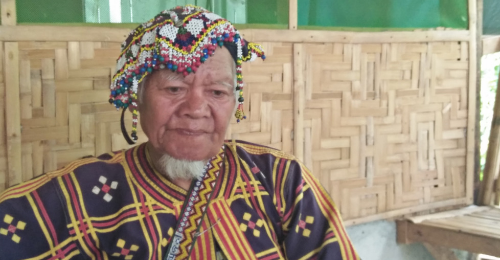
In June 10, 2018, Datu Guibang Apoga, a tribal leader who had waged war with the government for two decades in the hinterlands of Davao del Norte and Bukidnon surrendered and vowed to work with authorities, virtually ending one of the fiercest resistance by indigenous peoples (IPs) in the defense of their ancestral lands.
Apoga, a member of the Langilan-Manobo tribe, surrendered to the government during a tribal peace gathering at Barangay Palma Gil in Talaingod, Davao del Norte.
The tribal leader launched a “pangayaw,” or tribal war in 1993 against government troops and security personnel of logging firm Alcantara and Sons (Alsons). He had resisted the entry of the logging firm into the vast Pantaron Range that straddles the borders between Davao del Norte and Bukidnon provinces. Armed with just bows and arrows and improvised rifles, Apoga’s group attacked Alsons and resisted government troops sent to arrest him and his followers, forcing him to flee deep into the jungle.
He was slapped with several murder charges as a result of the attacks on Alsons guards and workers. Apoga lead the tribal resistance group Salugpongan Ta Tanu Igkanugon (Unity for the Defense of Ancestral Lands), which the military has labeled a communist sympathizer.
His son Awing said the reason for Datu Apoga to surrender was that he learned that there were more tribal and Lumad community killed by the NPA group and that the Salugpongan school which he organized was exploited by the NPAs.
Brig. Gen. Torres said based on the accounts of some teachers such as Awing Apoga, they taught anti government propaganda.
“So ibig sabihin it is not just a school na tuturuan ang mga bata to read and write, learn history, but its more than that,” Torres said. (They are not only taught to read and write, learn history, but more than that.)
“Last time we made a report in the Davao region there were 74 (schools) but most were already closed. But we are starting to assess and recognize its impact to the insurgency in the Philippines. (If there are) 74 schools to 20 students then they have almost 1,500 students that are hard core, educated from grade 1 to high school in these kind of teachings,” he said.After his surrender, Datu Guibang Apoga requested the government for the immediate closure of Salugpongan schools through a manifesto. He said the schools have lost its purpose since it is no longer educating lumad but instead recruiting them to join the NPA.
On November 27, 2018, the Community Tribal Council of Sitio Dulyan, Palma Gil, Talaingod, Davao del Norte acted on the manifesto for the closure of Salugpongan.
Accordingly the move triggered the group of former Representative Satur Ocampo and Francisca Castro, ACT representative, to go to the area.
On November 28, 2018, the group of Ocampo with 16 others went to Sitio Dulyan with the intention to transport 14 minors to the Haran compound.
According to Bae Pilar, the Indigenous Peoples Mandatory Representative (IPMR), there were already seven Salugpongan schools that were closed in Talaingod. Based on the record of the Department of Education, there are 73 private learning institutions in the region that have temporary authority to operate while 37 have pending applications for renewal.
Meanwhile, last May 31, the communities in Sitio Puting Bato, Barangay Ngan in Compostela, Davao de Oro (Compostela Valley) jointly demolished the Salugpongan school, wherein a new two- room building was built in the effort of the local government, barangay officials and other stakeholders.

